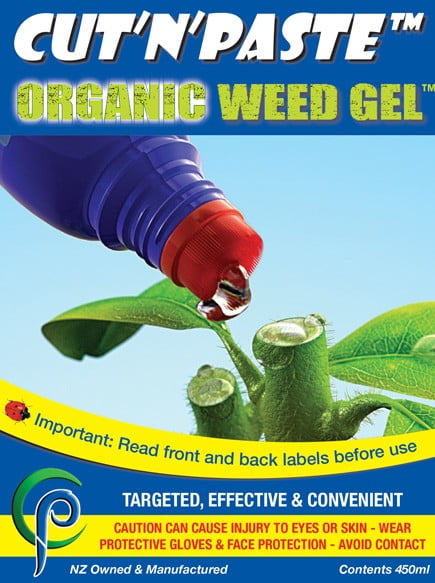Organic Gel

Directions
Make a level cut through the stem as close to soil as possible; scrape bark off any associated exposed roots. Liberally paste all exposed cut surfaces. For follow up, retreat any new shoots that may re-sprout. When applied to leaves only the treated leaves will be affected. Rinse the brush top after use to remove dirt and excess gel. Refill from bulk supply or recycle the container after triple rinsing.
Handling, precautions and equipment care
The active ingredient salt, is ground residual and can travel through soil, particularly when large numbers of weeds are treated in a small area. You are advised to take care when using next to desirable or known sensitive native plants or in areas where their roots might extend.
Do not use if rain is expected within two hours as the gel could leach onto wanted plants and effectiveness may also be reduced. Always use protective gloves when applying.
Cut’n’Paste Organic Gel contains acetic acid (at about twice that of normal vinegar) and you are advised to avoid breathing in the acrid fumes when working near newly applied gel.
The gel is highly unpalatable and unattractive to animals. Do not apply on or around food or animal feed crops or areas to be grazed by animals.
Storage
In tightly closed original container in a cool dark place, away from children and pets, foodstuffs, seeds, fertilisers and pesticides. Kept as recommended the gel will show no appreciable deterioration for at least two years from the Date of Manufacture (DOM).
Active Ingredient
20% Acetic Acid (Vinegar)
125g/kg Common table salt
Hazard classes. 6.1D, 8.1A, 8.2B, 8.3A, 9.1D, 9.3C
EPA HSR No.
First Aid Measures
Skin contact: prolonged exposure may cause skin irritation. Wash with soapy water. Remove and wash any soiled clothing.
Ingestion: dilute with several glasses of water. Do NOT induce vomiting.
Eye Contact: hold eyelids apart and flush with running water until stinging stops. Seek medical advice if prolonged irritation occurs, or advice ring 0800 764 766 National Poisons Centre.